The difference between anabolism and catabolism is mainly characterized due to the difference in the types of substrates participating, types of products forming and the type of metabolic phase.
Small monomers function as the substrate molecules in anabolism, whereas large and complex polymers serve as the substrate molecules in catabolism. Anabolic pathways typically form complex products, while catabolic pathways generally produce simpler products.
Anabolism is a constructive or biosynthetic process through which small molecules combine to form a large complex compound. Oppositely, catabolism is a destructive or energy-yielding mechanism through which a large complex molecule splits into smaller or simpler units.
Both anabolism and catabolism are the two common branches of metabolism through which body cells convert food into energy. Thus, metabolism is necessary for growth, movement and different cellular tasks.
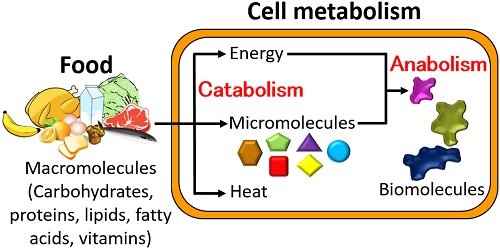
A specific set of hormones and regulatory enzymes control the anabolic and catabolic pathways. Therefore, anabolism and catabolism are enzyme-catalyzed reactions. This post discusses the key differences between anabolism and catabolism, along with the comparison chart, definitions, and examples.
Content: Anabolism Vs Catabolism
Comparison Chart
| Properties | Anabolism | Catabolism |
|---|---|---|
| Meaning | It merely refers to the biosynthesis of large biomolecule from monomeric or simpler units | It merely refers to the digestion of a large biomolecule into small monomeric units |
| Alternative names | Biosynthetic or reductive metabolism | Energy-yielding or oxidative metabolism |
| Reactants or Substrates | Simple compounds like monosaccharides and fatty acids | Large biomolecules like nucleic acids and proteins |
| Products | Large biomolecules like polysaccharides and triglycerides | Small or simpler compounds like nucleotides and amino acids |
| Type of metabolic phase | Constructive phase | Destructive phase |
| Mechanism | It involves a reduction and condensation mechanism | It involves oxidation and hydrolysis mechanism |
| Energy input | It requires ATP | It does not require ATP |
| Reaction energetics | It undergoes endergonic reactions | It undergoes exergonic reactions |
| Oxygen involvement | Oxygen is not required | It occurs in the presence or absence of oxygen, or both |
| Functioning time | It functions mainly during the resting phase | It functions under stress or during the active phase |
| Energy conversion | Kinetic energy is converted into potential energy | Potential energy is converted into kinetic energy |
| Hormones involved | Estrogen, insulin, testosterone etc. | Adrenaline, glucagon, cortisol, melatonin etc. |
| Major function | Growth and development of the living system | It gives the energy to perform different cellular tasks |
| During exercise | Anabolic processes increase muscle mass through isometrics and weight lifting | Catabolic processes decrease fat and calories through cardio exercises |
| Examples | Photosynthesis, gluconeogenesis and nucleotide synthesis | Cellular respiration, glycolysis and ethanol fermentation |
Definition of Anabolism
The biosynthetic metabolic phase involves a set of enzyme-catalyzed reactions constructing biomolecules or macromolecules from simple molecules. Anabolism is an endergonic process requiring energy input. Anabolic reactions are non-spontaneous,i.e. require energy from outside.
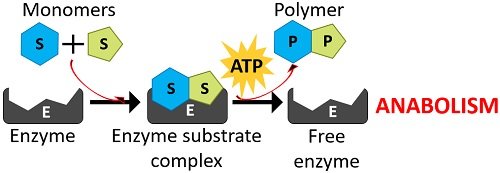
It converts kinetic energy into potential energy. Anabolism is necessary for cell growth and development. It involves condensation and polymerization reactions, as small molecules condense or polymerize into a large biomolecule.
Stages
The process of anabolism involves three consecutive stages of enzyme-catalyzed reaction:
- Precursor assembly: Precursors like amino acids, monosaccharides etc., assemble.
- Energy consumption: Precursors activate into reactive forms by using adenosine triphosphate as the energy source.
- Complex molecule formation: Precursors transform into complex molecules like proteins, polysaccharides etc.

Definition of Catabolism
It refers to the metabolic process that involves a set of enzyme-catalyzed reactions destructing large biomolecules or macromolecules into simple or micromolecules. Catabolism is an exergonic reaction releasing energy in the form of adenosine triphosphate. Catabolic reactions are generally spontaneous, which means cells can utilize the released energy in various forms.
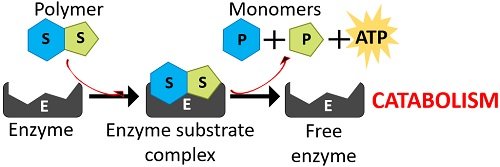
It transforms potential energy into kinetic energy. Catabolism releases ATP that becomes necessary to perform cellular and physical activities. It involves digestion and decomposition reactions, as large molecules split into small micromolecules.
Stages
The process of catabolism involves three consecutive stages of enzyme-catalyzed reaction:
- Molecular digestion: Large biomolecules degrade into smaller or simpler forms. For instance, an enzyme “Proteases” facilitate protein digestion into single amino acids.
- Energy release: Breakdown of biomolecule releases some energy in the form of heat as well as energy. Adenosine triphosphate is released as the energy source.
- Energy stored: The cell stores ATP to perform various cellular tasks like growth, reproduction and differentiation.
Examples of Anabolic Reactions
Photosynthesis in Plants: It is an anabolic process carried out by autotrophic plants. They produce different forms of carbohydrates like glucose, cellulose, starch etc., by fixing atmospheric carbon dioxide and using solar energy.
Gluconeogenesis: It is an anabolic pathway through which non-carbohydrate precursor molecules, i.e. three-carbon compounds (pyruvate or lactate), produce a hexose sugar, i.e. glucose. It occurs in case of insufficient dietary intake or prolonged starvation.
Nucleotide Synthesis: It is an anabolic reaction in which a combination of a nitrogenous base, pentose sugar and phosphate form the nucleotide through ATP hydrolysis.
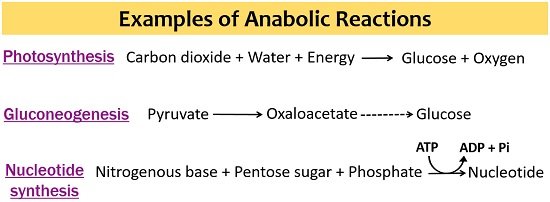
Examples of Catabolic Reactions
Plant Respiration: It is a catabolic process carried out by autotrophic plants. Here, they oxidize the organic forms of carbon, i.e. carbohydrates (like glucose, starch etc.), to form energy (ATP) with by-products like carbon dioxide and water. Entire cellular respiration produces 32 ATP molecules through three consecutive pathways like glycolysis, TCA cycle and electron transport chain.
Glycolysis: It is a catabolic pathway through which a set of enzymes oxidizes a hexose sugar (glucose) to give two molecules of a three-carbon compound, i.e. pyruvate. Oxidation per glucose molecule produces 2 ATP molecules.
Alcoholic or Ethanol Fermentation: Organisms like yeasts anaerobically convert sugars like glucose or sucrose into cellular energy ATP and ethanol with carbon dioxide as the by-product.
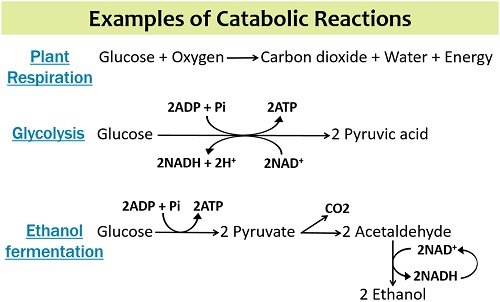
Key Differences Between Anabolism and Catabolism
- Anabolism is a constructive pathway that brings the biosynthesis of macromolecules through the association of monomeric or simpler units. Catabolism is a destructive pathway that brings the degradation of complex macromolecules into monomeric or simpler forms.
- Anabolic reactions facilitate the condensation of simple compounds like monosaccharides and fatty acids into large biomolecules like polysaccharides and triglycerides, respectively. Catabolic reactions induce the degradation of large biomolecules like nucleic acids and proteins into small or simpler compounds like nucleotides and amino acids, respectively.
- Anabolism is an endergonic mechanism that consumes energy in the form of adenosine triphosphate. Oppositely, catabolism is an exergonic mechanism that releases energy as adenosine triphosphate.
- Catabolic hormones like adrenaline, glucagon, cortisol, melatonin etc., induce catabolic reactions in our body and function during the active phase. Anabolic hormones like estrogen, insulin, testosterone etc., influence anabolism in our body, working during the resting phase.
- Catabolism performs a significant role in providing energy to the cells to perform various tasks, whereas anabolism performs a key role in cell growth and development.
- Photosynthesis, gluconeogenesis and nucleotide synthesis are examples of anabolic reactions. Cellular respiration, glycolysis and ethanol fermentation are examples of catabolic reactions.
Conclusion
Anabolism and catabolism are the processes that we go through in our daily life. Like, the sun provides the primary source of energy to all the life forms. For instance, producers or autotrophs like plants utilize the energy released by the sun’s fusion reactions to form sugars that could be in the form of mono, di and polysaccharides. Thus, photosynthesis is an anabolic process.
Then, consumers like animals and humans intake the food containing complex polysaccharides, vitamins, proteins, etc. and digest them into simpler forms to get energy through ADP phosphorylation. Cells utilize the energy to construct tissues and other bodily structures. Thus, food digestion is a catabolic process. Therefore, anabolism and catabolism are the two processes that occur over and over again.
